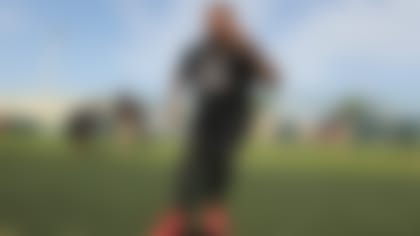Speed is a skill, and a skill must be practiced. The skill of speed can be trained anywhere at any time with little or no equipment. Although we use many tools to train speed, such as sleds, bands and treadmills, below are three exercises that don't require the use of any tools. When you don't have equipment, you often make the excuse of not being able to train, but the most successful athletes understand where there is a will to get better, there is a way.
NFL Up!

Watch more NFL Player workouts for great training tips. More...
1) Line Hops for Foot Quickness
Foot quickness can be trained in a variety of ways including the use of a jump rope, speed ladder or dot drill pad. However, one of the best ways to train foot quickness is the use of a line on a court, a football field, or even the sidewalk. The goal is to move over the line without touching it; hopping from front to back, side to side, progressing from two feet to one foot on each exercise. These exercises are done with 10 seconds of work and 30 seconds of recovery between each rep.
Athlete Focus: Move at your "fastest controllable" speed.
Coaching Takeaway: "The longer the foot is on the ground, the slower you are."

San Diego Chargers defensive back Brandon Flowers shows how you can increase speed and quickness without any machines or equipment. (Perry Knotts/NFL)
2) Hill Sprints for Acceleration
Acceleration in a straight line can be trained in a number of different ways. Many of the exercises that are used to develop speed and acceleration involve the use of treadmills, sleds, bungees, parachutes or resistance bands. One of the best ways to train acceleration with no equipment is the use of a hill. There are several ways to progress this particular exercise. You can increase the yardage of the sprint, increase the number of sprints, or increase the number of sets. The goal is acceleration so focus on distances between 10-20 yards. Typically, younger athletes will start on a gradual incline and progress upwards with age and physical maturity. When running hills, the focus should be on knee drive upward and arm swing backwards. Each rep should last less than six seconds with at least 60 seconds of rest. Remember that the difference between speed and stamina is the recovery time between each rep. I like my athletes be fully recovered before they start the next rep or else the hill sprints could become conditioning and not a speed training exercise.
Athlete Focus: Drive knees and arms aggressively.
Coaching Takeaway: Allow the athlete to fully recover between sprints. "A tired athlete is a slow athlete."
3) Wave Drills for Change of Direction Speed
Speed is not always running in a straight line. Football players such as wide receivers are asked to decelerate and accelerate immediately when running a route such as the comeback. Therefore, I consider agility drills to be an important part of developing "football speed."
The wave drill requires no equipment and is one of the favorite position drills used at the NFL Combine each year. You only need a partner who is verbally directing the athlete to change directions on a cue. This verbal cue allows athletes to develop what is known as cognitive athleticism (thinking and reacting) Sharp cuts should be made front to back and side to side at the command of the partner's voice. "Shuffle," "backpedal," and "sprint" are the three commands given within the 10 seconds of each repetition. The faster you can stop and start, the more effective you will be on game day!
Athlete Focus: React to commands as fast and as efficiently as possible.
Coaching Takeaway: Ensure that athletic posture (ankles, knees, hips are bent, and chest up) is maintained throughout the duration of the exercise.
Want more workout tips from the pros? Vote for your favorites at NFL Up!
- Clif Marshall is the Performance Director at Ignition® where he is responsible for the design and implementation of both the strength and speed programs for all athletes.



